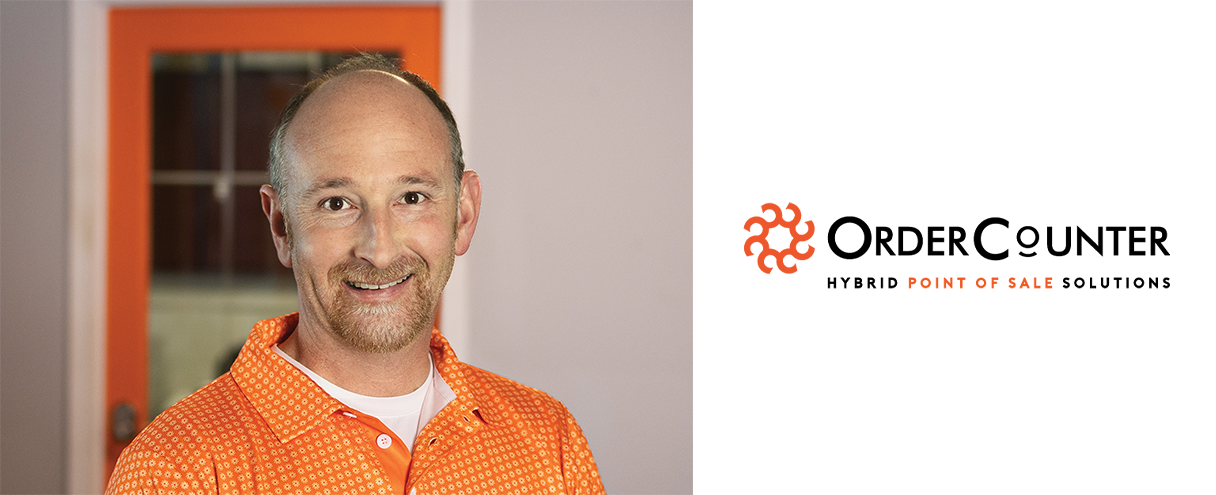KitchenHub talked to Brian Edwards, Chief Product Officer at OrderCounter.
For those who haven’t heard of the company, OrderCounter provides point-of-sale technology and related services to businesses worldwide.
Brian
Could you please tell our readers a bit about yourself?
With over 20 years of experience in tech and hospitality, I’ve founded and scaled companies, led product and operations teams, and remained hands-on with innovation. I built and ran Everything But The Food for over a decade before it was acquired by onePOS, where I later served as EVP. I also co-founded WeighUp, a patented liquor inventory platform. Along the way, I’ve been honored with awards like Executive of the Year and RSPA’s Retail Technology Pacesetter.
This sounds really impressive. You are now successfully driving the development and refinement of OrderCounter’s product. Our audience is likely familiar with POS systems and OrderCounter in particular, but there will also be readers who aren’t as deep into the details. Could you describe the product for them?
We’ve spent almost 20 years focused on the hospitality industry, but we’ve recently started expanding into retail and salon/spa with dedicated divisions for each. That setup really lets us grow into new areas without losing focus on what we’re best at – hospitality. Our POS platform includes powerful cloud-based tools like online ordering and e-gift cards, and it runs seamlessly on Windows terminals, the latest Android handhelds, and more. The goal is to give users a simple, modern, and reliable experience no matter how they use it.
How is OrderCounter different from other companies? What are your main advantages?
A good number of things make us stand out! One is our cloud-hybrid architecture, which gives you the best of both worlds: the reliability of local servers with the convenience of managing your business from anywhere.
We’re also very serious about data privacy and staying processor agnostic, which gives our clients and partners flexibility and control.
On top of that, the system is incredibly customizable and packed with features. And while we integrate with a number of third-party partners, we’ve also built our own add-ons for things like online ordering, gift cards, loyalty programs, kiosks and more. It’s a full ecosystem that’s powerful but still affordable.
Can you share any success stories that highlight the tangible benefits restaurants have achieved by implementing OrderCounter?
Our clients love how stable and fast the system is. Pure cloud systems sound great until the internet slows down or goes out, and suddenly, the POS, the heartbeat of the entire operation, grinds to a halt. That’s where our hybrid setup shines. They get local server speed and reliability but can still manage everything remotely. It really is the best of both worlds!
On the flip side, can you tell me about the company’s challenges or failures? I guess it helps to inspire those just starting out in the restaurant business
As for challenges, we made a few hiring mistakes after COVID. We didn’t move quickly enough to make changes when things weren’t working out because we genuinely wanted to help people succeed and find the right fit. Looking back, we should’ve trusted our instincts sooner. The good news is that the team we have today is incredible, and we’re operating at the highest level in company history.
For a new restaurant owner evaluating POS systems, what three features would you say they should absolutely prioritize?
First, focus on speed and reliability. Forget the flashy stuff that doesn’t actually move the needle for your operations, step back and ask yourself how many taps it takes to do something you’ll do hundreds of times a day. Many times you’ll find the fancier looking systems take a LOT longer to accomplish basic tasks.
Second, make sure you have flexibility in payment processing. After labor and overhead, it’s often one of your biggest costs. Some POS companies lock you into their own processing and can raise your rates anytime.
Always read the fine print, and be careful with “free” systems – those deals usually come with strings attached that you could end up hanging out to dry from.
And finally, avoid long-term contracts with massive cancellation penalties. Make the company earn your business. The best vendors will have no problem with that.
What are the company’s plans for the future, if you don’t mind sharing?
We’re continuing to invest heavily in our hospitality business. It is the foundation and where we continue to have a lot of success. We’ve brought on several industry veterans to our leadership team this year to help us continue to scale while improving operations and growing our partner network. At the same time, we’re growing into new verticals like retail and salon/spa through dedicated divisions. That way, we can build on our core platform and add the features those industries need without losing sight of what’s made us successful so far.
As someone deeply involved in the restaurant industry, what emerging trends are you noticing right now?
Labor is still a big challenge, and we’re seeing more operators embrace self-service and robotics to help with that. The smart ones are using these tools to enhance hospitality, not replace it with tech. For example, instead of using robots to cut back on staff and handle a lot of guest interactions, they’re using them to run food or handle repetitive tasks, which frees up the team to spend more time with guests. That approach boosts efficiency, lowers cost and actually improves the guest experience. It’s technology supporting people, not replacing them.
What would you never have believed possible in the industry 10 years ago? What has surprised you the most?
Honestly, if you’d told me ten years ago how different the POS landscape would look today, I might have giggled a little bit. There’s been so much change. Many mergers, acquisitions, and brand names that once dominated the industry have either faded away completely or become unrecognizable. We barely run up against some of the companies that once literally set the standard. It’s been fascinating, and a little surreal, to watch that shift happen.
What’s surprised me most, though, is how the industry’s attitude toward service has evolved.
For a while, it felt like operators cared less about the relationship they had with (and the quality of service they received from) their POS provider, even though it’s the most critical system they rely on every single day! You’d think hospitality people, of all folks, would value great service above all else, right? However, over time, I believe the pendulum has begun to swing back. We’re seeing an increasing number of operators who want genuine partnerships and high-quality service. And support. They want people who pick up the phone, know their business, and genuinely care about their success. That’s been one of the best changes to watch!
I can’t help but ask about KitchenHub's partnership with OrderCounter.
Note: With KitchenHub and OrderCounter integration, you can sync online orders directly to your POS, have a unified dashboard for all channels, and more.
Our clients love that they can use KitchenHub to eliminate managing all of those tablets by having all of their orders from third parties like DoorDash, UberEats etc., going straight into their OrderCounter POS, which saves them time, money, and improves order accuracy. The two-way menu syncing is also great, as it allows operators to add or update a menu item in OrderCounter and have those additions or adjustments automatically populated on all of their third-party delivering sites.
One of the things we appreciate about working with the KitchenHub team is the responsiveness. Not only do they answer questions fairly quickly, but they are also open to enhancing their platform in thoughtful ways that improve the partner and restaurant operator experience.




